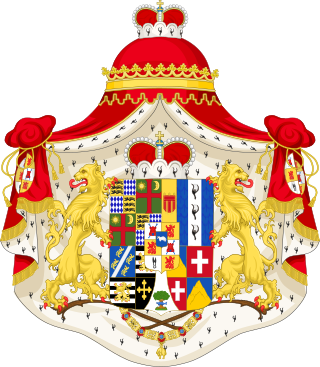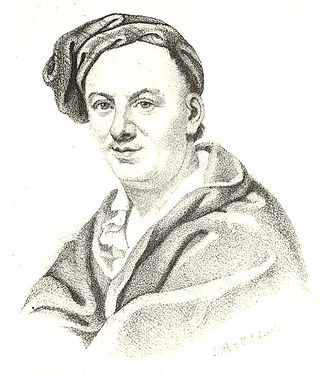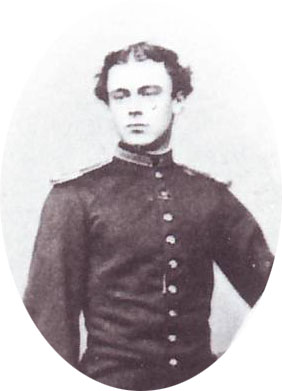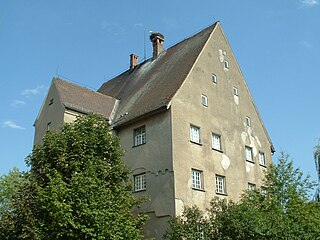
The Princely House of Thurn and Taxis is a family of German nobility that is part of the Briefadel. It was a key player in the postal services in Europe during the 16th century, until the end of the Holy Roman Empire in 1806, and became well known as the owner of breweries and commissioner of several castles. The family has resided in Regensburg since 1748 with their seat at St. Emmeram Castle from 1803. The family is one of the wealthiest in Germany, and the current head of the House is Albert, 12th Prince of Thurn and Taxis.

Gloria, Dowager Princess of Thurn and Taxis is a German noblewoman, socialite, businesswoman, Catholic activist, and artist. Through her marriage to Johannes, 11th Prince of Thurn and Taxis, she acquired the courtesy title Princess Consort of Thurn und Taxis.

Saint Emmeram's Abbey was a Benedictine monastery founded around 739 at Regensburg in Bavaria at the grave of the itinerant Frankish bishop Saint Emmeram. The original abbey church is now a parish church named St. Emmeram's Basilica. The other buildings on the site form a large complex known as Schloss Thurn und Taxis or Schloss St. Emmeram, which has served as the main residence of the Thurn und Taxis princely family since the early 19th century.

Ignaz Günther was a German sculptor and woodcarver working in the Bavarian Rococo tradition.

Peter Anton von Verschaffelt was a Flemish sculptor and architect.

Johann Baptist Zimmermann was a German painter and a prime stucco plasterer during the Baroque.

Albert Maria Joseph Maximilian Lamoral, 8th Prince of Thurn and Taxis was the eighth Prince of Thurn and Taxis and Head of the Princely House of Thurn and Taxis from 2 June 1885 until his death on 22 January 1952.
The Czech branch of the House of Thurn and Taxis is a dynastic cadet branch of the Princely House of Thurn and Taxis, a German noble family that was a key player in the postal services in Europe in the 16th century and became well known as the owner of breweries and builder of many castles.

Maximilian Karl, 6th Prince of Thurn and Taxis, full German name: Maximilian Karl Fürst von Thurn und Taxis was the sixth Prince of Thurn and Taxis, head of the Thurn-und-Taxis-Post, and Head of the Princely House of Thurn and Taxis from 15 July 1827 until his death on 10 November 1871.

Duchess Therese Mathilde Amalie of Mecklenburg-Strelitz was a member of the House of Mecklenburg-Strelitz and a Duchess of Mecklenburg. Through her marriage to Karl Alexander, 5th Prince of Thurn and Taxis, Therese was also a member of the House of Thurn and Taxis.

Paul Maximilian Lamoral, Prince of Thurn and Taxis, was the third child of Maximilian Karl, 6th Prince of Thurn and Taxis and his second wife Princess Mathilde Sophie of Oettingen-Oettingen and Oettingen-Spielberg. He was buried in Cannes, at the Cimetière du Grand Jas, Allée du Silence no. 33 under the name of Paul de Fels.

The Palais Thurn und Taxis in Frankfurt, Germany was built from 1731 to 1739 by Robert de Cotte and commissioned by the Imperial Postmaster, Prince Anselm Franz von Thurn und Taxis (1714–1739).
Prince Gabriel Albert Maria Michael Franz Joseph Gallus Lamoral of Thurn and Taxis was a Prince of Thurn and Taxis. Gabriel was second in the line of succession to the Headship of the House of Thurn and Taxis after his father Franz Joseph, Hereditary Prince of Thurn and Taxis until his death in the Battle of Stalingrad, at which point he was replaced by his uncle Prince Karl August of Thurn and Taxis.
Max Emanuel Prinz von Thurn und Taxis was the heir presumptive to the nominal title of Fürst von Thurn und Taxis that is held, according to the traditional house law of the former German princely House of Thurn and Taxis, by his nephew Albert, 12th Prince of Thurn and Taxis. Max Emanuel was a member of the former German princely House of Thurn and Taxis, whose wealth derived from founding the German postal service and brewing.

Duino Castle is a fourteenth-century fortification located in the village of Duino, located in the municipality of Duino-Aurisina, near Trieste, modern-day Italy, on the cliffs overlooking the Gulf of Trieste.

Untersulmetingen Castle is a small castle-like renaissance structure in the village of Untersulmetingen, now part of the municipality of Laupheim, in the state of Baden-Württemberg, Germany.

The Battle of Ludwigshafen and the subsequent bombardment of Ludwigshafen lasted from 15 to 18 June 1849 and was part of the Palatine Uprising and Baden Revolution. The young settlement of Ludwigshafen was badly damaged by the shells of the Baden artillery and the resulting fires.
Hugo Wilson is an English artist and sculptor.

Mergentheim Palace is a historic building located in Bad Mergentheim, Germany. The palace was first a castle, built in the early Middle Ages as the seat of the Taubergau, but then became a Teutonic possession in 1219, and then seat of the Mergentheim Commandery. The castle became the residence of the Grand Master of the Teutonic Order in 1527 and remained the headquarters of the Order until 1809.

St. Sebastian is the oldest Catholic parish church in the city of Mannheim and one of the three churches of the Mannheim city pastoral unit in the city center. In Electoral Palatine times it was used by the Elector as a court church and received a magnificent interior by artists such as Bibiena, Verschaffelt and Egell. The furnishings were impaired by remodeling in the 19th century and damaged during World War II. Together with the Old Town Hall, St. Sebastian's Church forms a Baroque double building erected at the beginning of the 18th century, which is the oldest preserved structure in the city.
















